Suriname
Suriname, South America - December 2023
Suriname is a small country on the northern part of South America. As one of the Guayanas, there is a history of colonial influence. The Dutch granted indpendence to Suriname in 1975. Dutch remains one of the primary languages spoken in the country. Sranan Tongo, an english-based creole language, would be the second most prominent language.
One of their allures is being the country with the highest proportion of forest cover in the world. Believed to be 90%, the tropical rainforest covers almost all of the country. Working with a local ecotourism guide, there was promise of adventures through uninhabitated rainforest to find tropical herps.
Seliba River - Day 1
The first day starts early in the Miami airport. The previous night required traveling from Vermont to Newark, New Jersey before boarding a red-eye to Miami where we attempted to get any sleep we could. A mini shower in the airport sink to help wake up gets us from Miami to Panama City before landing in Paramaribo, Suriname.
From the airplane it is hard to argue with the claim of Suriname being the most forested country. All we could see for most of the journey was the occasional brown river snaking through the green canopy towards the Atlantic Ocean which melted into the sky. As we began to descend we flew through our first tropical rainstorm. On the other side a rainbow was added to the already dreamlike view. As we neared the city of Paramaribo, the occassional cleared lot broke the contiguous forest.
On the ground we were picked up by our guide Matthew Wallace of Unlock Nature. Immediately we head out to the Seliba River where we would be staying for the first few nights. An hour drive out of the city followed by an hour south by boat and we were putting on our boots to start looking.
Before I was ready to leave my tent, my travel companions had found our first herps of the night. An emerald eye tree frog would be the first herp while the first snake, only moments later, would be a snake from the genus Helicops. These snakes are the equivalent of North American Nerodia as they are the common watersnakes of South America. Common names include Brown-banded watersnake, South American Water Snake, and Amazonian Water Snake. I am mostly confident that we only came across Helicops angulatus and all references to Helicops going forward will assume such.
These are funky looking snakes with eyes similar to anacondas that are almost on top of their head. Less smelly than the iconic nerodia musk. More colorful individuals to come.
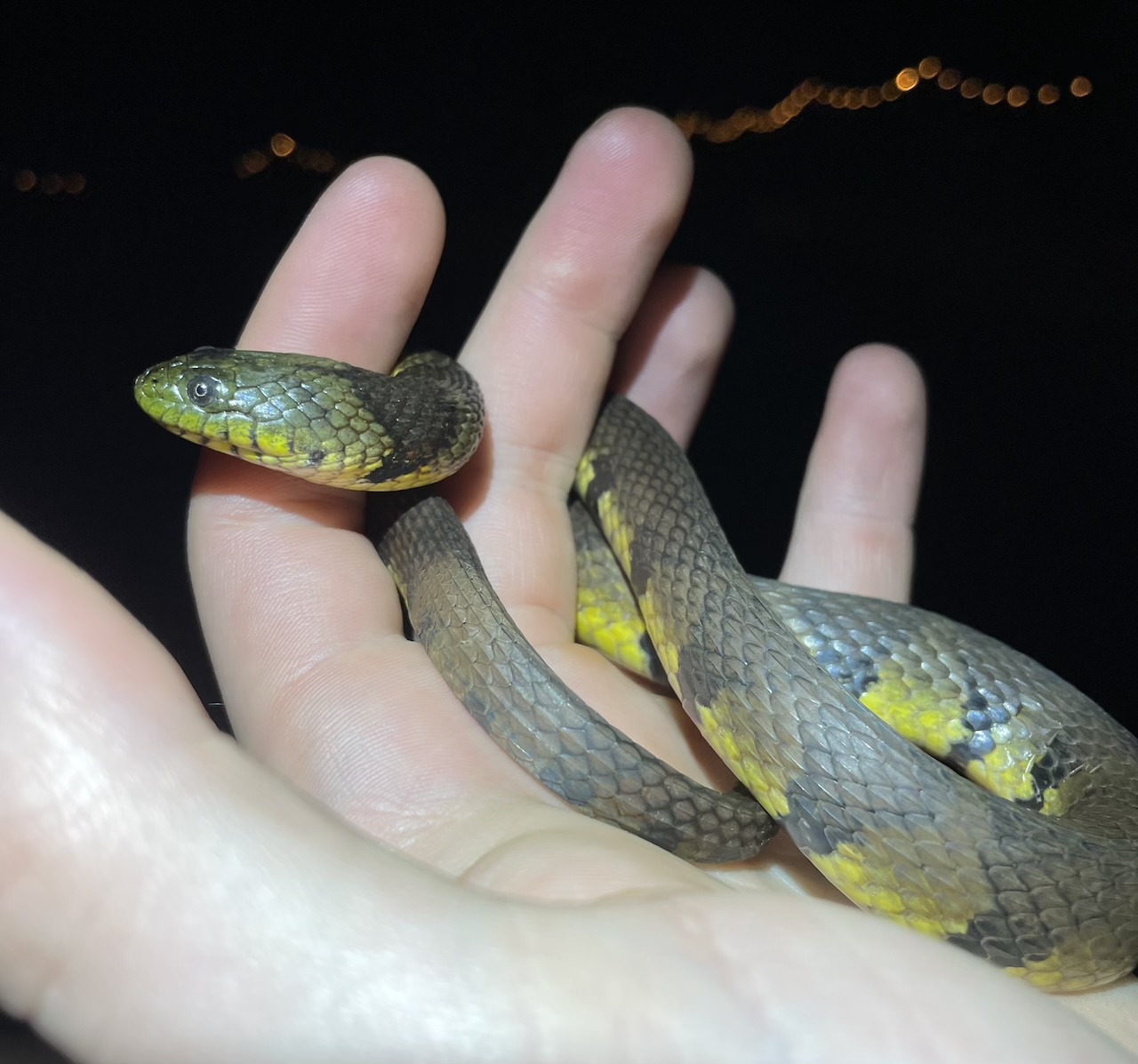
With base set up along the Suriname River and a stream running through the center of camp, we expect to see many more of these to come and if we are lucky a Suriname Coral Snake too. However, much of our hiking will occur on a loop trail that goes out back of camp and into the rainforest.
A couple of steps down the trail and “SNAKE!” is already called out. Unfortunately, the prep for tropical habitats is difficult due to the large diversity of snakes one can encounter. Efforts are increasingly difficult when you factor in that there are few english resources for Suriname snakes. All this to say that myself and my two North American companions were not going to be identifying snakes at a quick glance tonight. Let alone after over a day of straight travel directly into a rainforest hike.
This snake was on the crawl heading over some tree roots and was gingerly kept in the open while our guide confirmed that it was in fact a coral snake mimic and not the highly venemous coral snake. I believe this was a mimic of the collared coral snake and a prime example of Batesian mimicry as once we were confident it was a mimic there was no venom concerns.
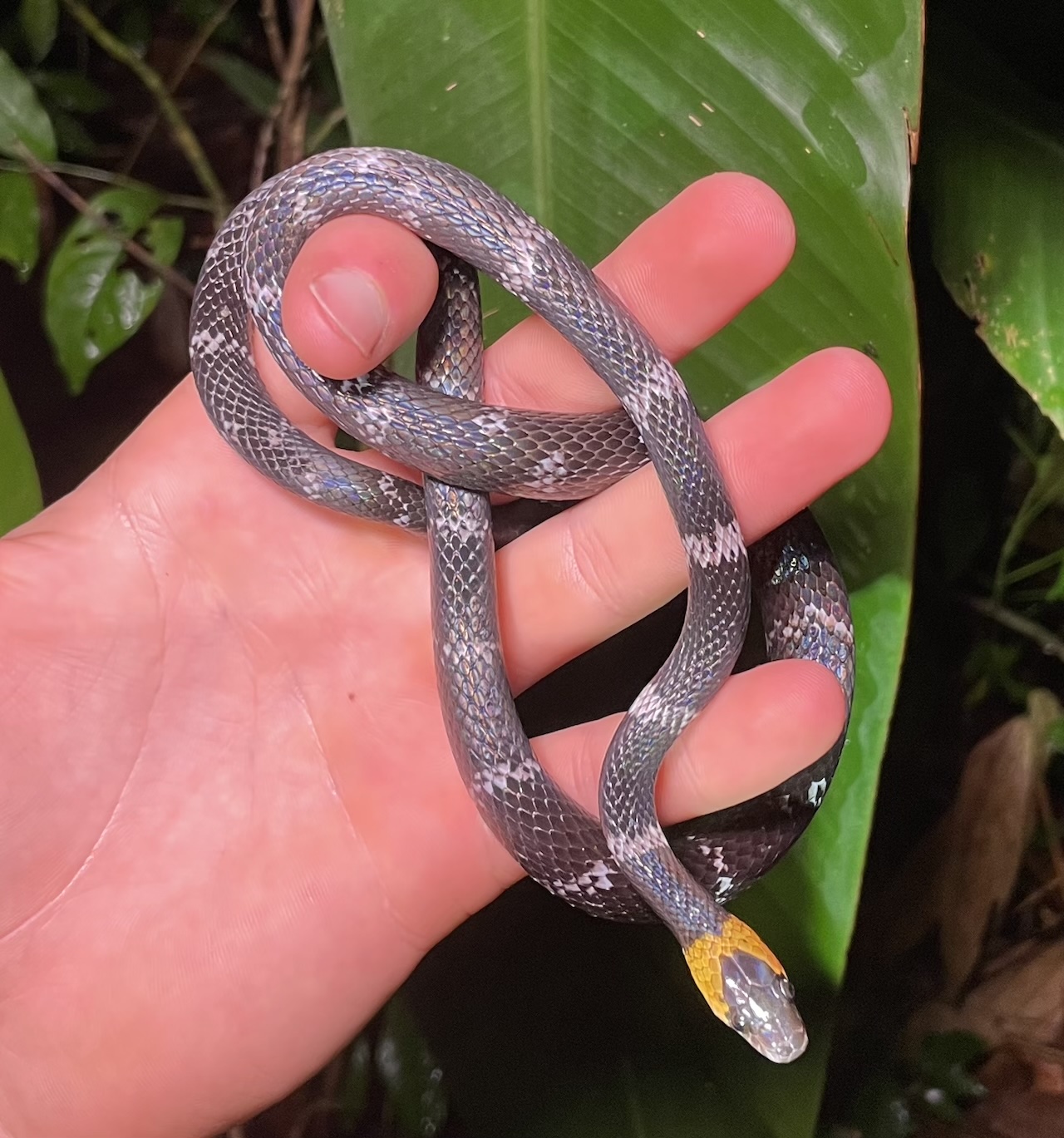
For the next hour after that explosive start we trudged through upland forest, thick swamps, and crossed small streams. This break in wildlife was appreciated as we took in the habitat. In awe of the massive trees, avoiding spiky bushes, or keeping an eye out for bullet ants takes a trained eye to do while looking for snakes at the same time. This time was not unproductive as we were still spotting small creatures. We came across a Spix’s Snouted Tree Frog (Scinax nebulosus) spotted by the outline of its shadow under a leaf.
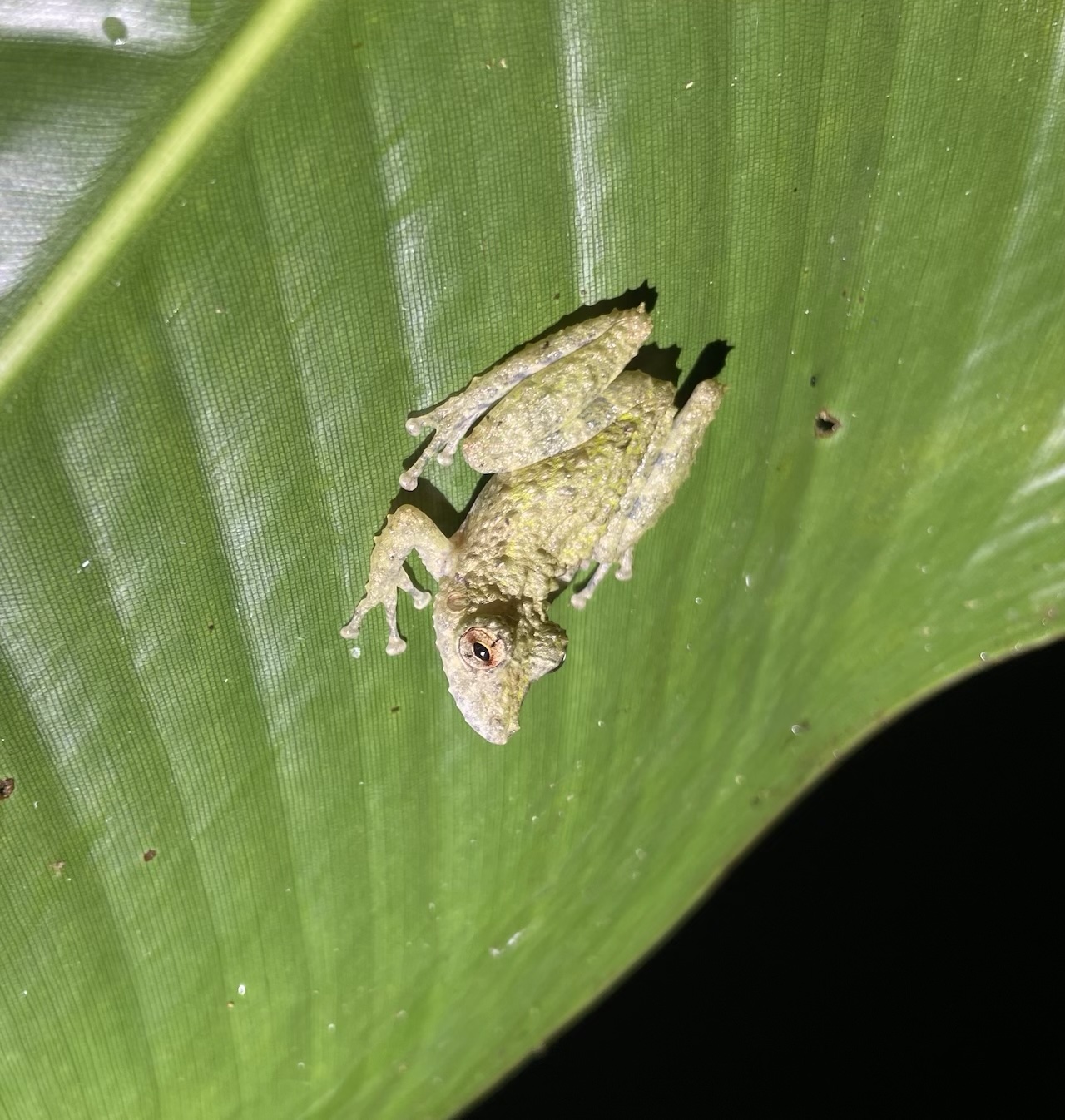
More conventially spotted were a three striped poison dart frog and tiger striped frogs (not pictured). The amphibian diversity is astounding.
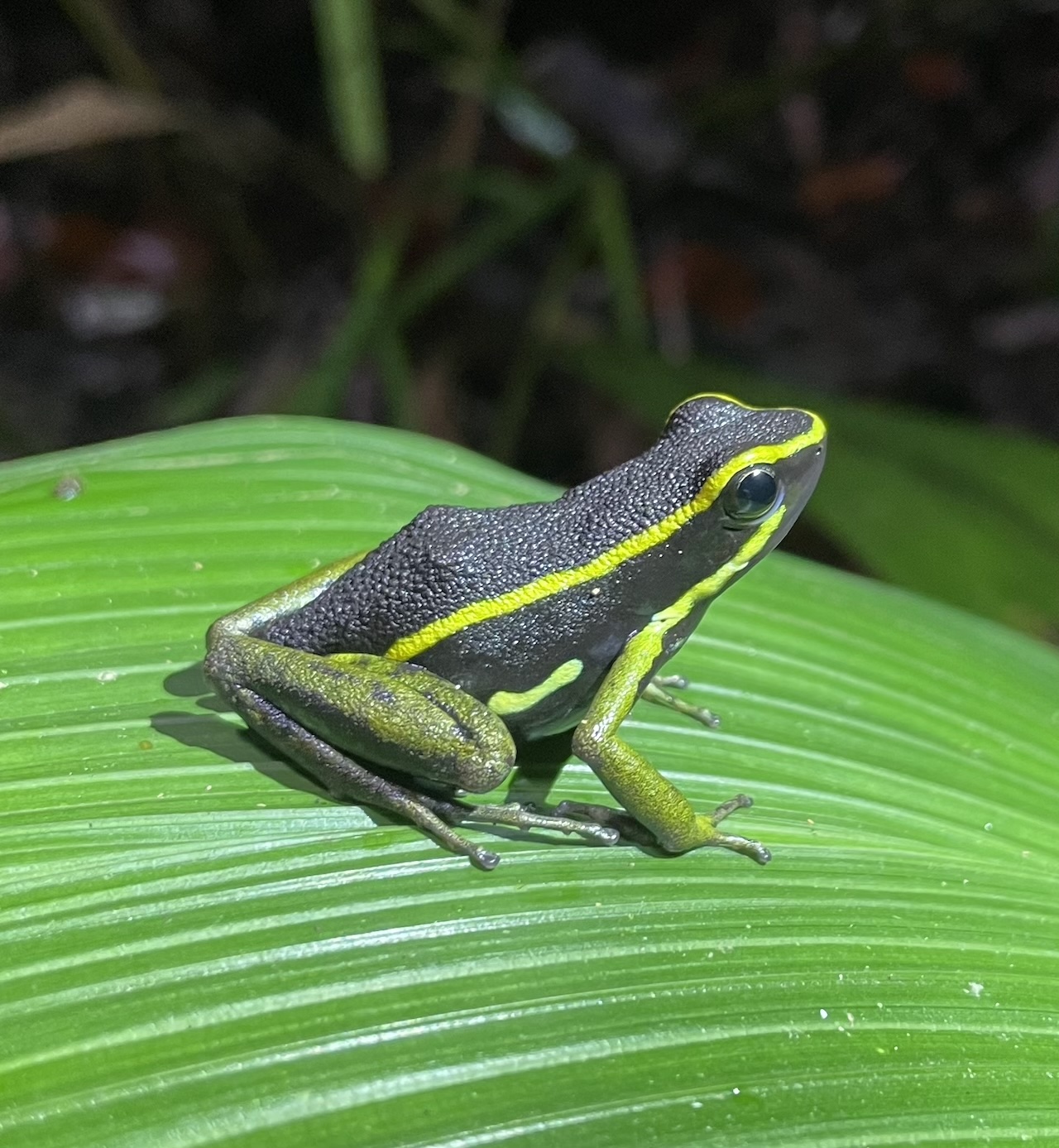
Before coming out of the forest to walk a road back to camp, we spotted a snake resting up in some low trees!
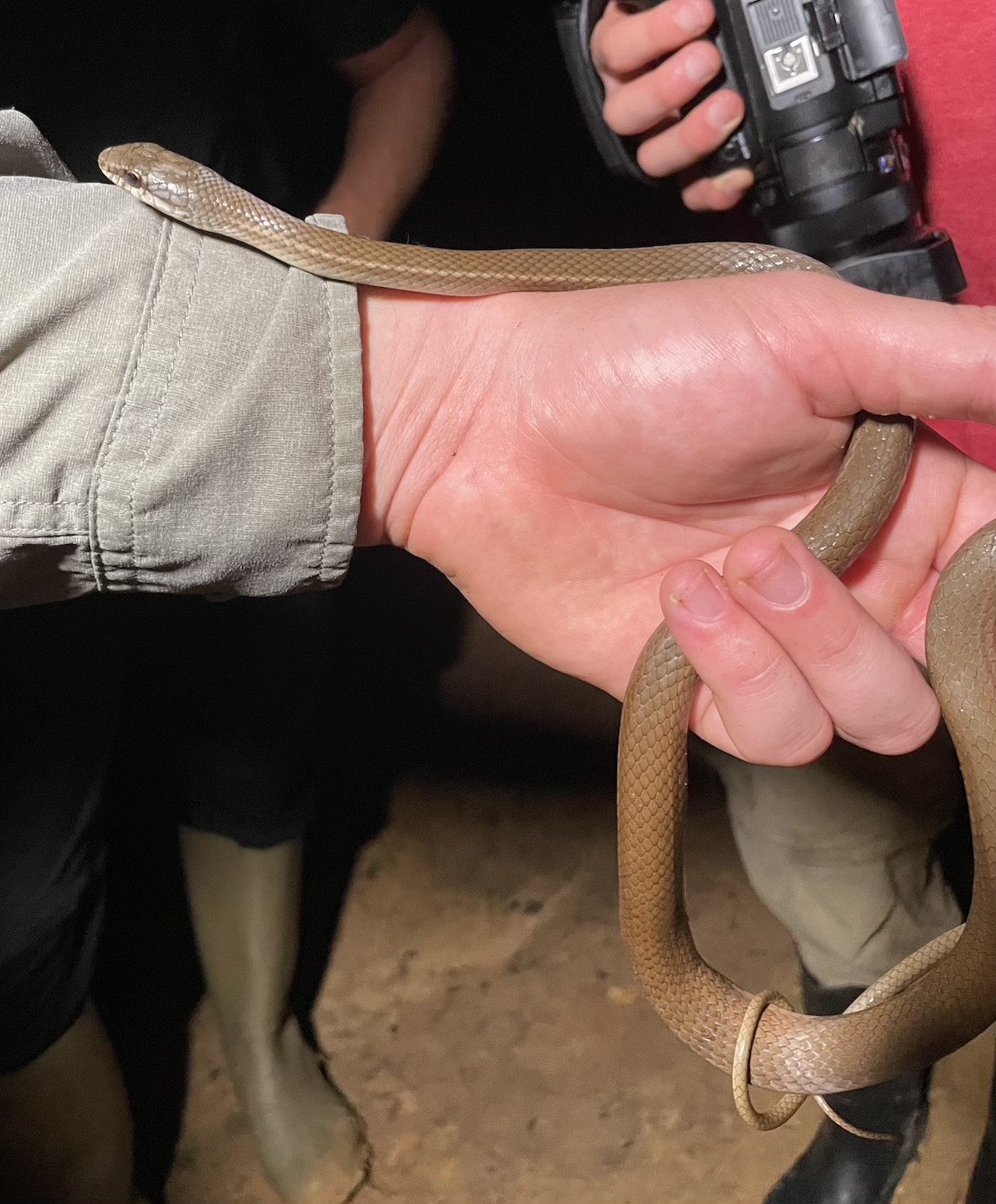
Our first Sipo of the trip! These snakes are fairly common but really cool to come across. Commonly they are referred to by their genus of Chironius, but a name more familiar to North American herpers would be Whipsnake. A fun snake to find, although they can be a little fiesty which is always fun to deal with on an international trip. Not nerve wracking at all. Anyways, this particular diurnal snake, Chironius fuscus or the Brown Sipo, was fairly calm, or sleepy, when we disturbed it. In the rainforest, these snakes are semi arboreal probably to better allow it to stay dry and allow for more animals to be prey. This will not be the last snake found asleep in the trees.
In fact, just down the road we would find a Boddaert’s Tropical Racer!
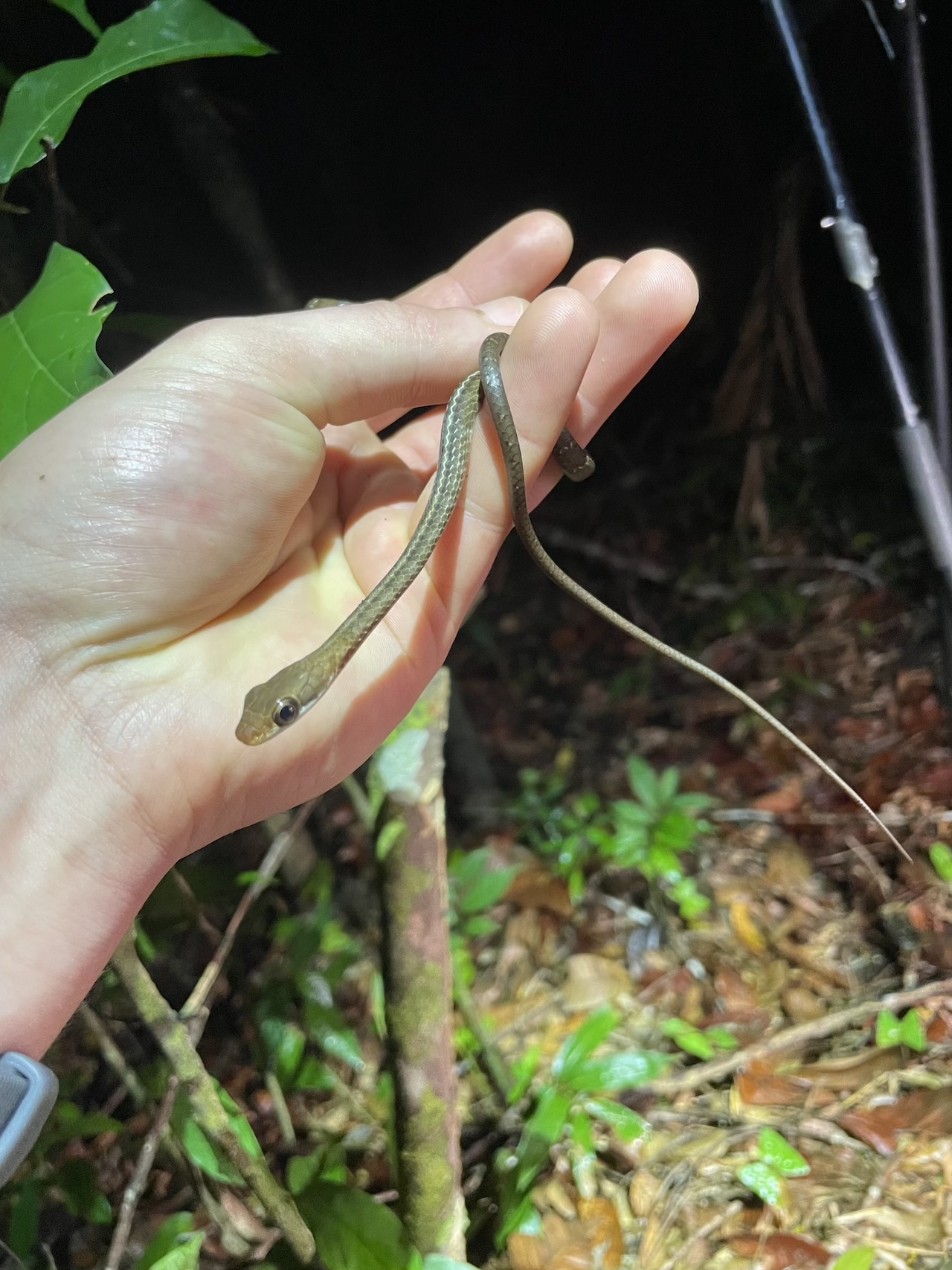
And not much further, another Sipo! This one was larger and is believed to be a Chironius carinatus which can be called a Sipo, Golden Keelback, or a Machete Snake. This one leaned towards being called a machete snake as it lived up to the expecation of aggressive defensive behavior. It bit anyone who put their hands near it which in combination with the anticoagulent in their saliva produced a harmlessly bloody mess.
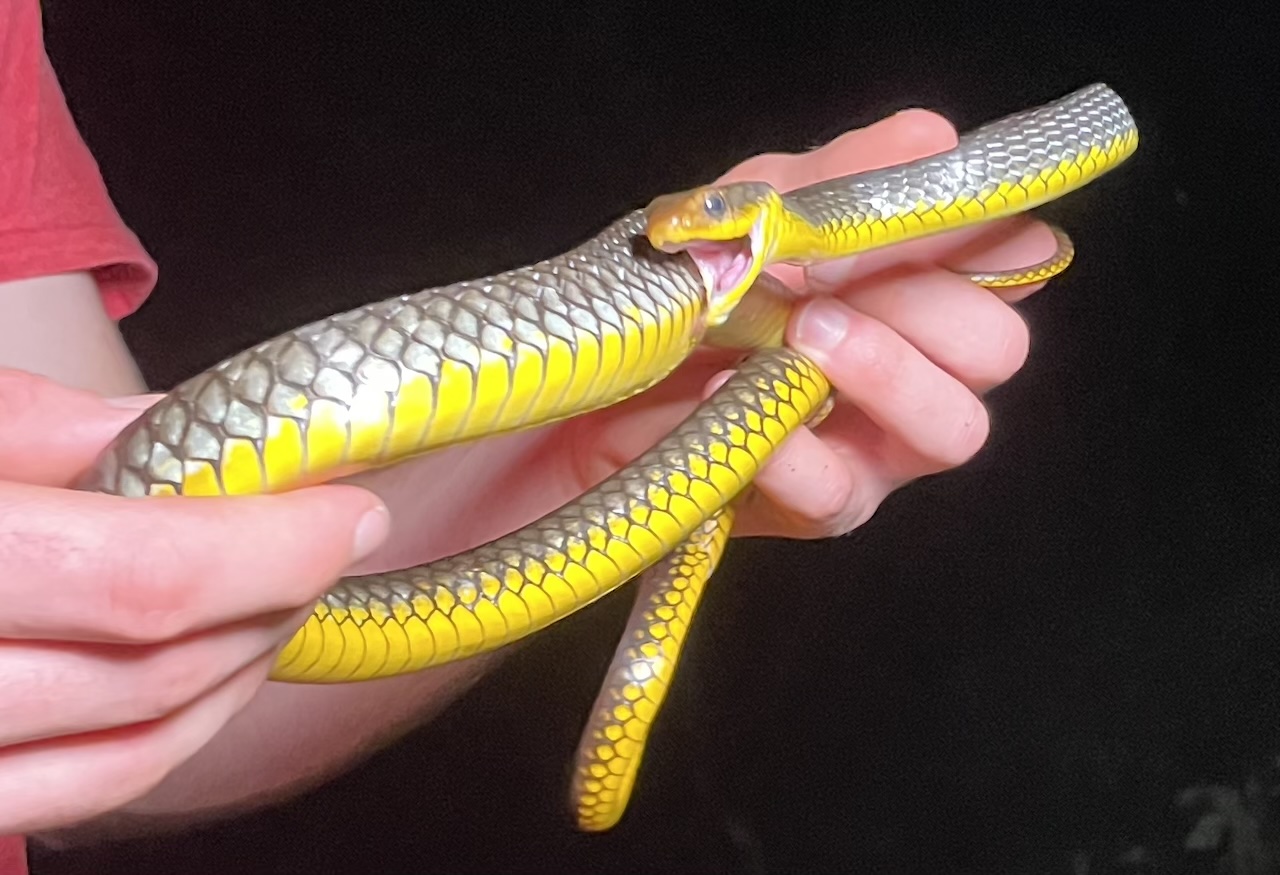
Back at camp, we were not ready to end the night of excitement and meandered around the edge of the clearing shining trees. It turned out to be a great idea as we came across our first Boa!
These snakes, Amazon Tree Boas, were one we were hoping to come across passively as they are expected to be fairly common. This juvenile was quite colorful still boasting a vibrant orange pattern. Unfortunately, known for their phenotypic variation and striking colors there is high demand for them in the pet trade which is leading to declining populations across Suriname. This would turn out to be only one of two we see all trip which was below expectations.
As we tried to minimize our celebrations over the great find, one of the property guides, Shak, wanted to share a recent find with us. Down the trail we had just walked he had found an emerald tree boa, the crown jewel of Suriname snakes, this past week. Seeing as the emerald tree boa is a primary target of the trip, it took virtually no convincing even though it was nearly 2am at that point. And our enthusiasm paid off!
This massive snake was maybe five feet off the ground frozen in an ambush position. Contrary to the diurnal Chirnoius and Boddaerts Tropical Racer, boas are out at night hunting small mammals in the trees. Usually this occurs 10s to 100s of feet into the canopy so getting this close of a look was mind blowing. Unfortunately, on day 1 of the trip we had not established responsible light practices and many of my photos were poorly lit as headlights came on and off the snake. Thankfully it would not be our last.
Pretty quickly, everyone began to crash from the day 1 excitement and we headed back to camp to sleep. One last scan of the stream yielded a bright orange Helicops before everyone passed out.
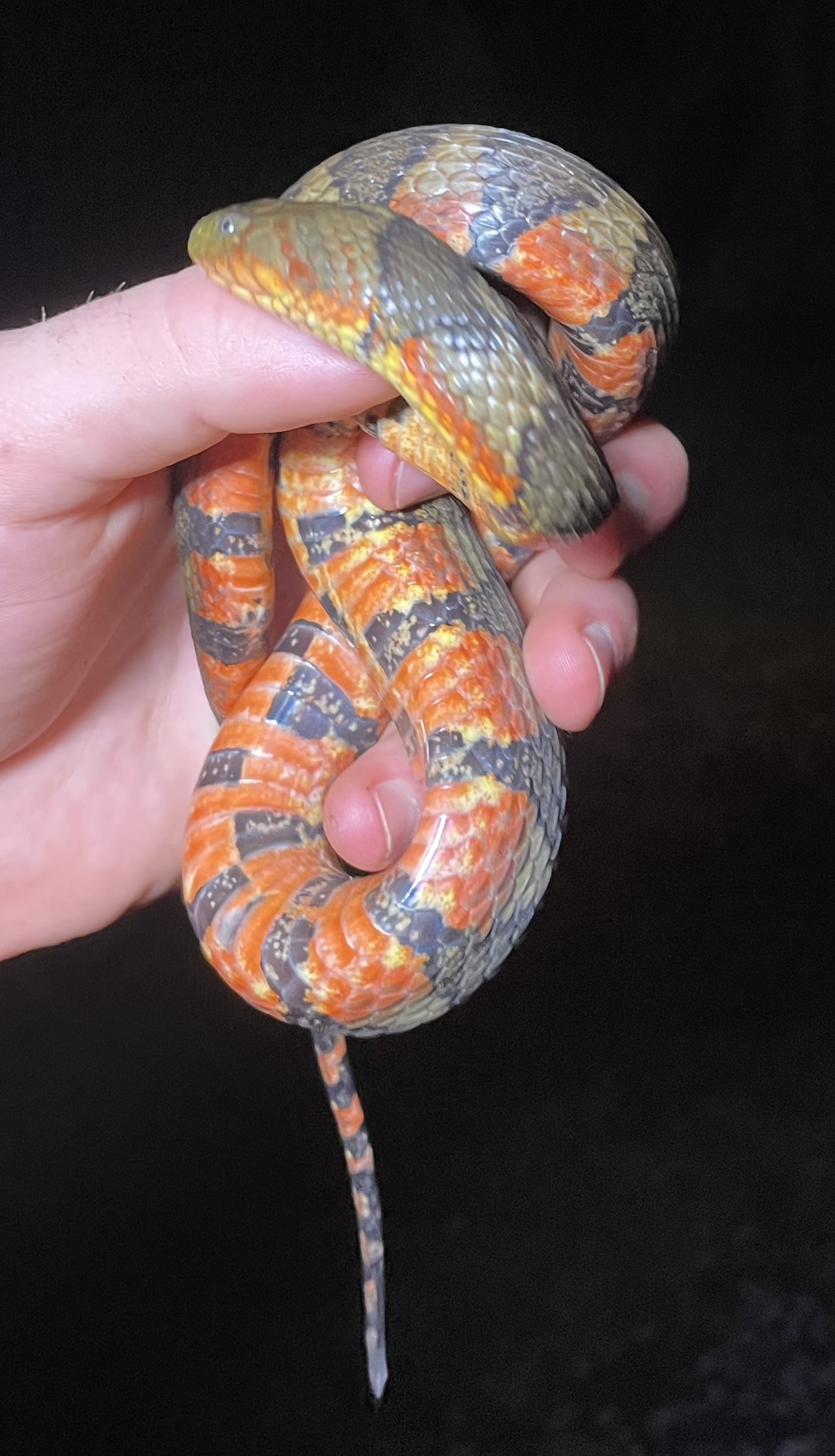
Seliba River - Day 2
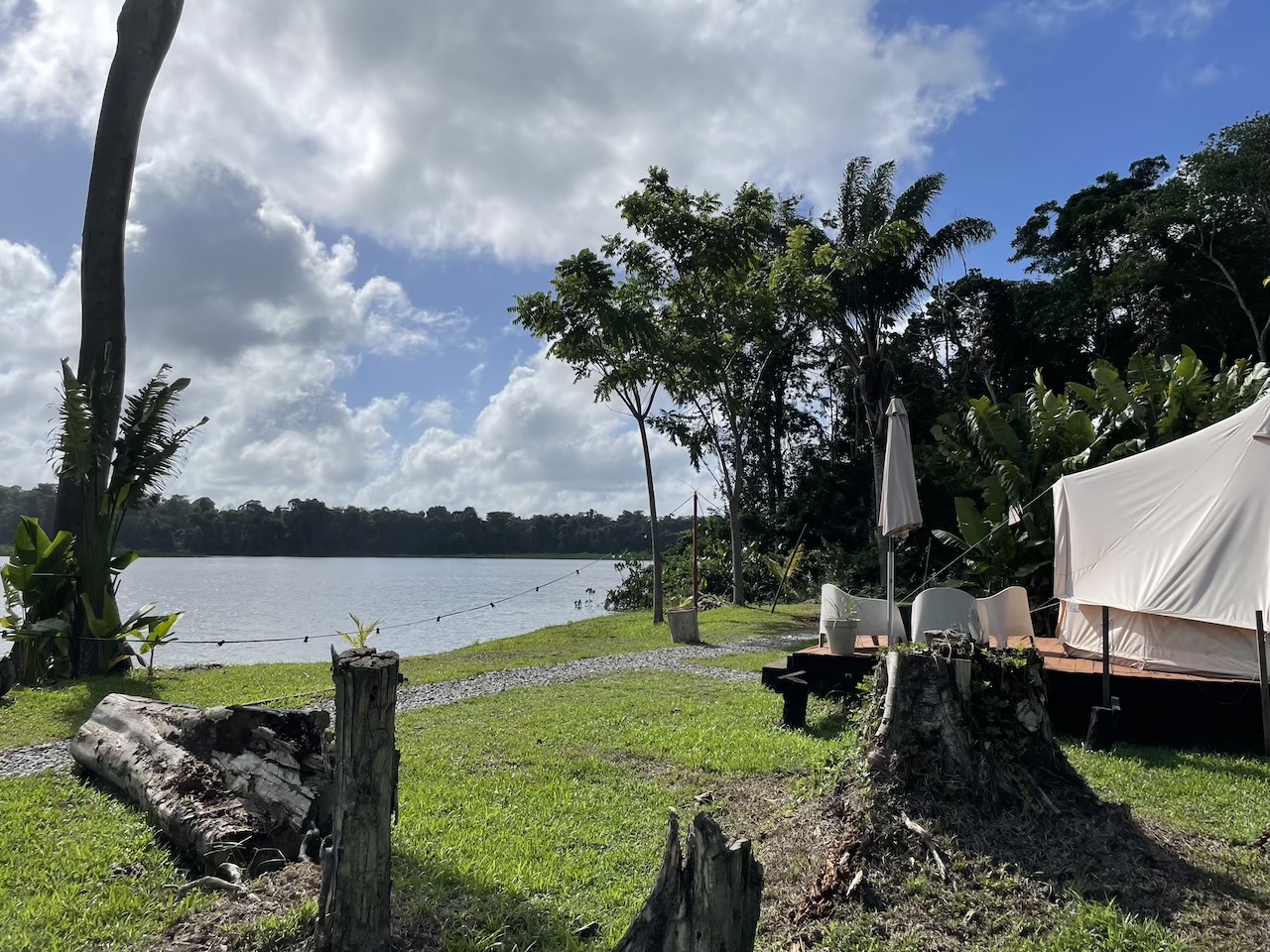
Finally able to see the Seliba River during the day, we are stunned. We are quite literally in a little outpost along the river with the rainforest at our backs. A slow restful morning allows us to fly the drone to see the area from above and walk the trail during the daylight. Aside from a pink toed tarantula, the focus is planning out the night time hiking.
Before long, nighttime is upon us. This time rather than going through the dense rainforest along the trail, we target edge habitat. We start the night by shining along the edge of the Seliba River from a boat but are quickly turned in by some hard rains. Attempt 2 starts by shining along the road edge as we head to some swamps scouted out during the day. Along the road we spot another Sipo alseep in the trees. Surprisingly, we find a Green Sipo, our third sipo species. After a little work to get it down, we have it in hand and can admire it up close.
<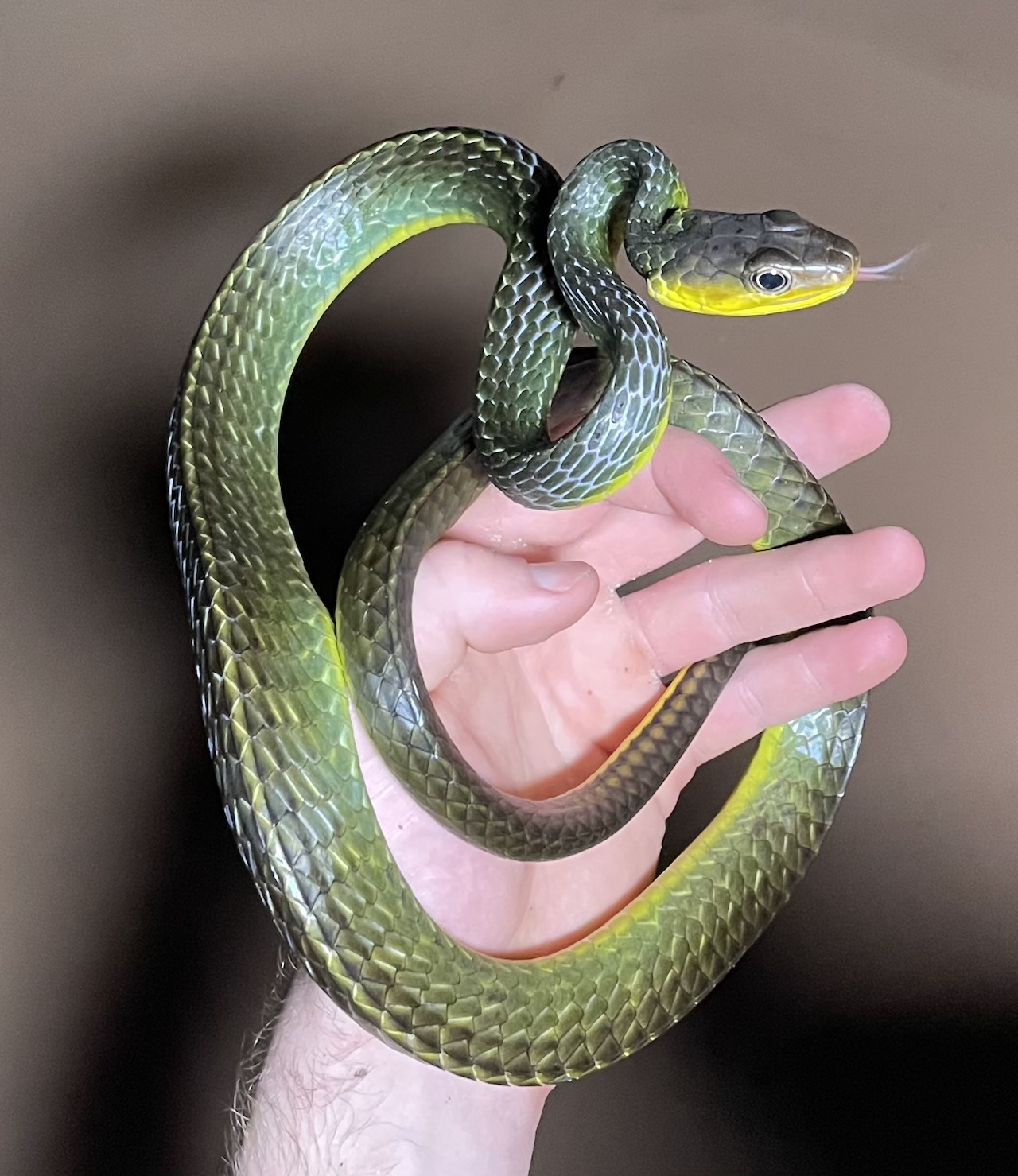
Continuing along to the swamps we find a hotbed of activity. In what appears to be the start of a canal, we come across some more Helicops and a pair of Giant Leaf Frogs in amplexus.
Moving along the canal, we spot a pair of eyes reflecting our flashlight back at us. Quickly, three of us are splashing through the water and scanning for where they went under. I happen to see a tail slowly floating by my leg make the call and let someone else come for the grab. A Dwarf Caimen!
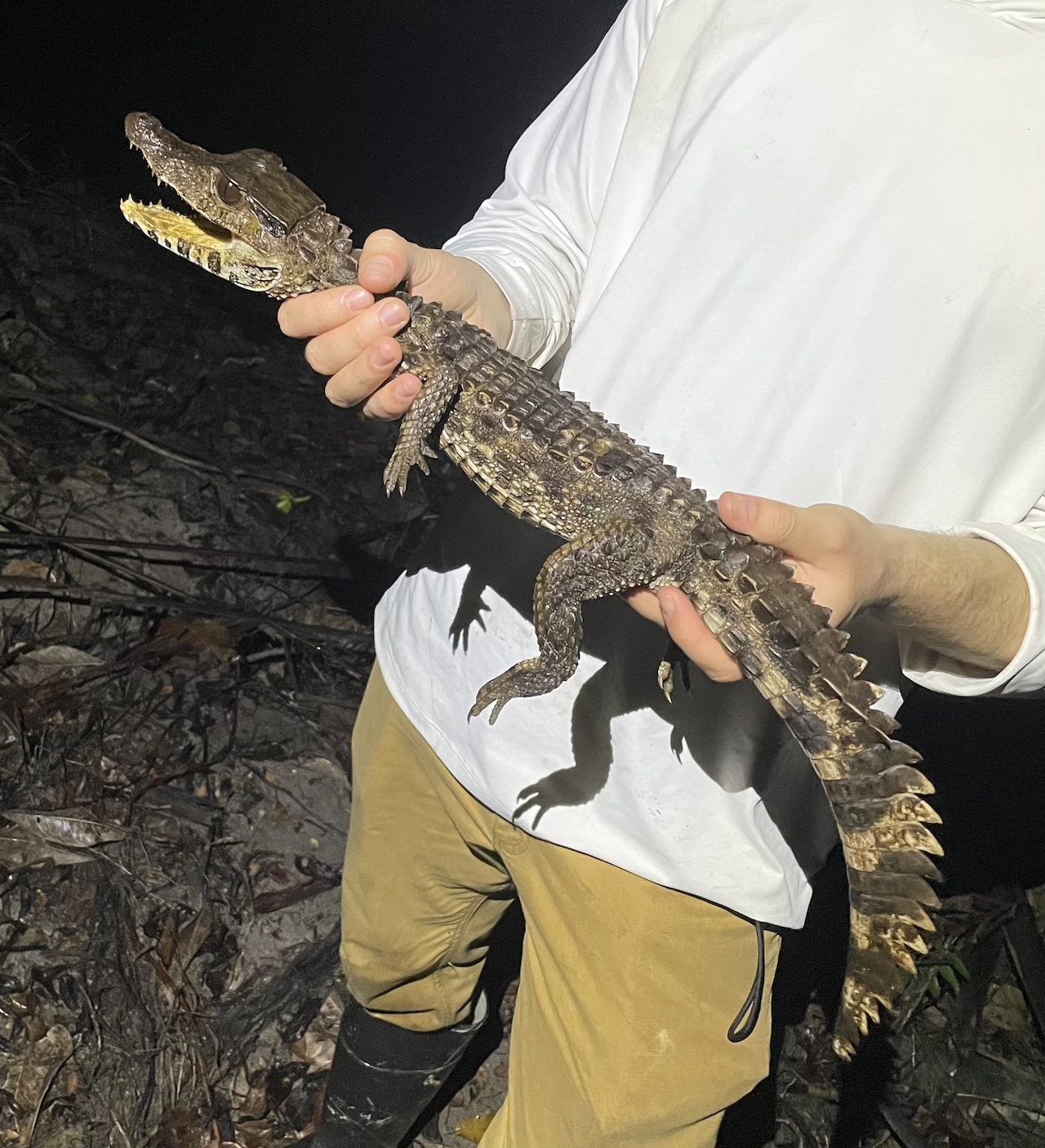
On our way back to camp at the end of the night we stop by a pond behind camp and find it full of amphibians. As we work from one end to the other we come across a common suriname toad. Don’t be fooled by the name however, as suriname toads (Pipa pipa) are known for being completely flat, fully aquatic, and females “incubating” their eggs on their back. It has unique appendages as the front toes are star-shaped. It lacks a tongue and feeds using a suction method that rapidly draws water into its body engulfing any nearby particles or organisms.

Brownsberg National Park - Day 3
Day 3 marks the end of our time on the Seliba River. Much of the day passes traveling to our second destination, Brownsberg National Park. This area has a histoty of utilization, or exploitation, of natural resources. In the early 1900s this area was marred with gold miners which eventually failed and was replaced by mining attempts for other resources. In the mid to late 1900s it became a national park allowing for ecotourism and was subsidized by the government. After Suriname was granted independence, funding slowly began to drive up and as gold prices rose mining returned to the region. Mining was evident directly by the swathes of clear cut forest and large mining camps around the outskirts. As you get further in, the evidence was indirect. Locals claim that the government is removing funding to dissuade people from using the National Park to allow for the gold miners to return unbeknowst to the public. These efforts could be seen by the treacherous, unmaintained road (we witnessed a car turn around as it was unable to pass a steep, slick stretch) or the dilapidated buildings and infrastructure. There was no potable water and we were without electricity for half our stay. There are also controversies around the Brokopondo Reservoir which was dammed to provide electricty to plants processing mining materials. This dam reportedly displaced towns, destroyed sections of rainforest, and has led to the harvesting of the flooded, petrified trees by foreign companies.
That being said, we were sufficiently prepared for the remoteness of the experience and were looking forward to the new habitat producing some new snake species. We got there in the afternoon and went for a hike to a local waterfall. On the way, we spotted a Boddaert’s Tropical Racer moving through a clearing.
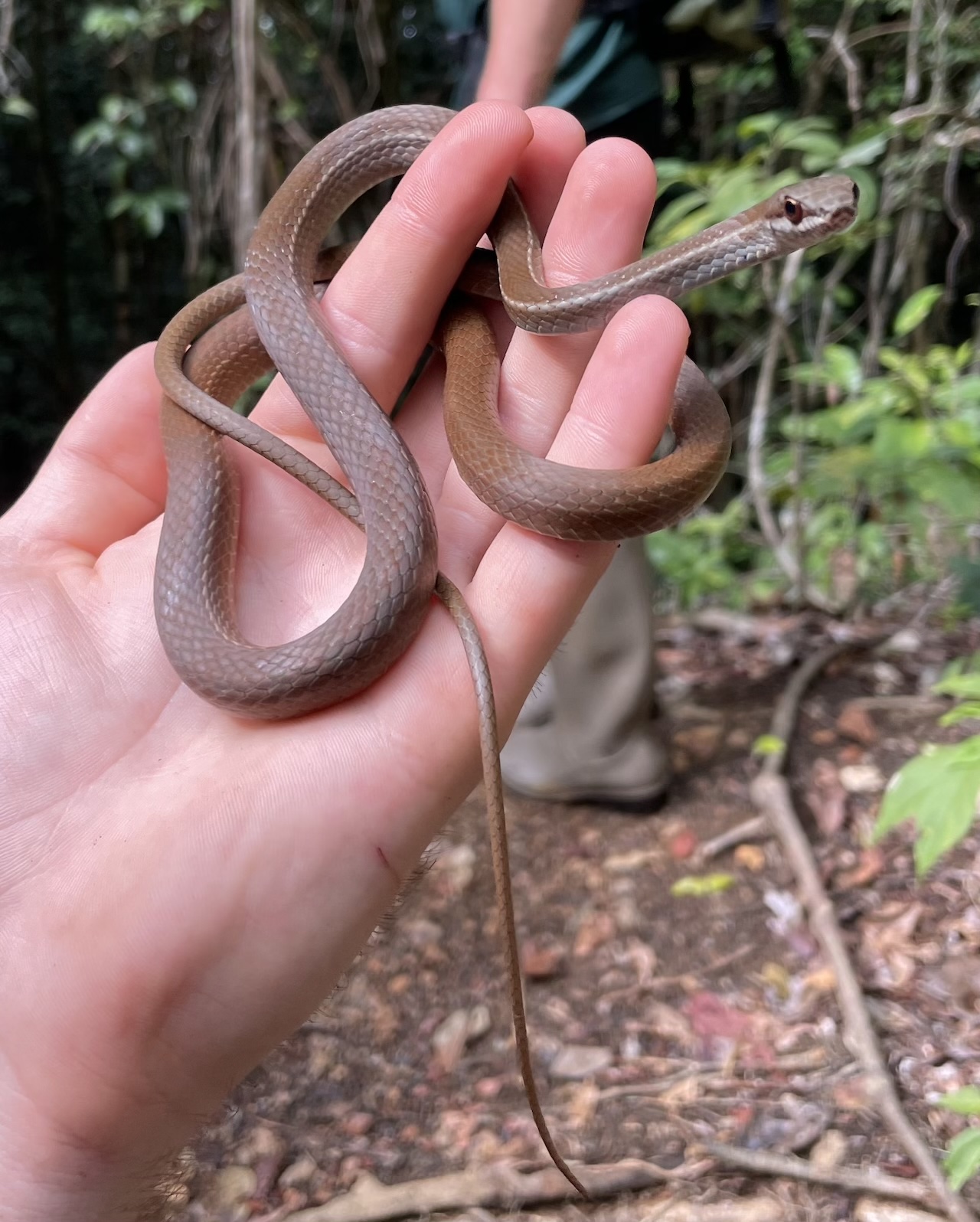
As we stopped to photograph it, we realized that we sat down next to boa constrictor eating a lizard under some tree roots!
This was a crazy sighting as Boa Constrictors are rarely seen in the National Park. As is common around here, and in high demand in the pet trade, it had the characteristic red tail. As we neared the waterfall we found some harlequin toads (Genus Atelopus).
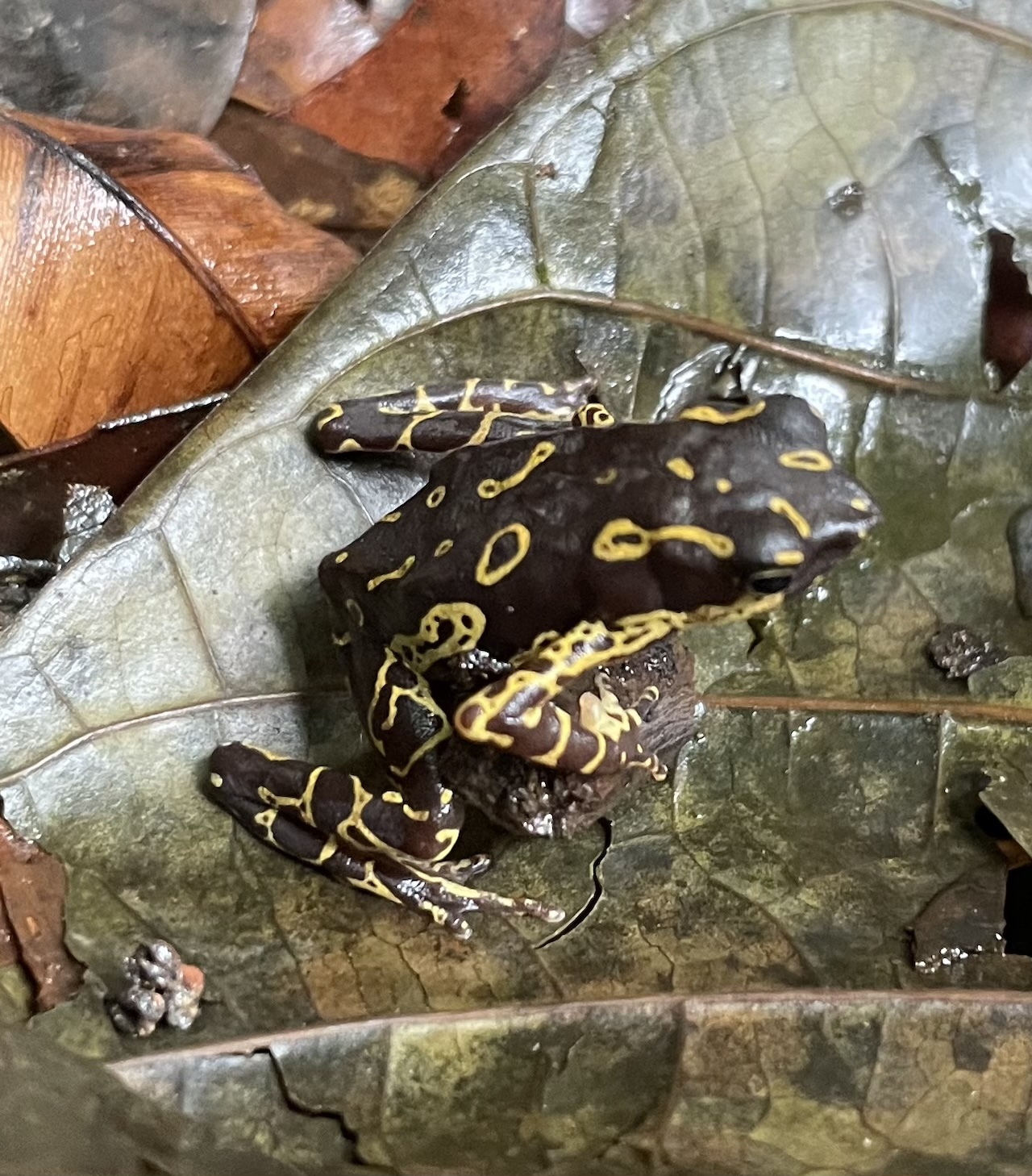
By the waterfall, there is a resident caimen living in a cave known to eat the bats within. It was home, but given recent global events no one was enthusiastic to crawl through a cave of bats to see it. To our surprise there were no snakes found along the stream below the river. However, as we started back, it was not long before we came across our first labarria. Pattied up on the side of the trail waiting for some unsuspecting prey or a human to step too close.
Labarria is the Surinamese local name for the South American Fer-de-lance or lance head. These vipers are well known within their territory as dangerous inhabitants that send multitudes of people to the hospital each year with bites. I have come across the terciopelo (Bothrops asper) in Costa Rica and now have had the pleasure of encountering the labarria (Bothrops atrox).
On the drive back to camp, we drove by a flock of Grey-winged trumpeters who we would find to live within close proximity of our shelter.

Late afternoon and evening consisted of naps, refueling, preparing for the night expedition, and waiting out a heavy rainstorm.
Five feet from our abode, with half of the group still asleep, our primary target for the night was spotted. A Two-Lined Forest Pitviper (Bothrops bilineatus) nearly 40ft up in a tree. Too far to photograph however the distinct blueish green color and reflective skin was enough to confirm the sighting. With some extra pep to our step, we were hoping this was a sign that the rain didn’t send snakes into hiding.
On our way out of camp, a second labarria on the day was spotted in the corner of some old foundations. Tonight’s goal is to shine some more arboreal snakes, preferably a two-lined pitviper closer to the ground and some more emerald tree boas. Our eyes would be up, covering as much of the canopy as we can make out as we walk along the road and search any clearings we come across. Out on the road, we quickly came across some more wildlife. What looked to me like a soggy mess of fur was a sloth trying to stay warm through the night. Either that or it was camera shy as we did not see it later that night when we returned.
The second clearing we came across gave us another chance at a two-lined pitviper. It was about 20ft up a tree and the group was determined that this was a conquerable height. After a couple iterations of bad and unsuccessful ideas, a nearby tree limb with a fork in its branches was crafted into an arm for snake retrieval. To my surprise, it was not long before the viper was out of the tree and at eye level.
The night turned out to be a huge success. Snakes appeared to be on the move or on the hunt. After that pitviper we came across 2 emerald tree boas, 2 blunt-headed snakes (the only non-lifer of this trip), 2 labarria, a ground snake, and a twist-neck turtle (Platemys platycephala).


Brownsberg National Park - Day 4

The second day in Brownsberg was quite similar to the first in structure, but more time was spent searching which yielded fewer snakes. The morning into the early afternoon was spent day cruising and hiking the same roads we walked the night before. Came across quite a few lizards, geckos, caecilians, and a Guyana Blind Snake.
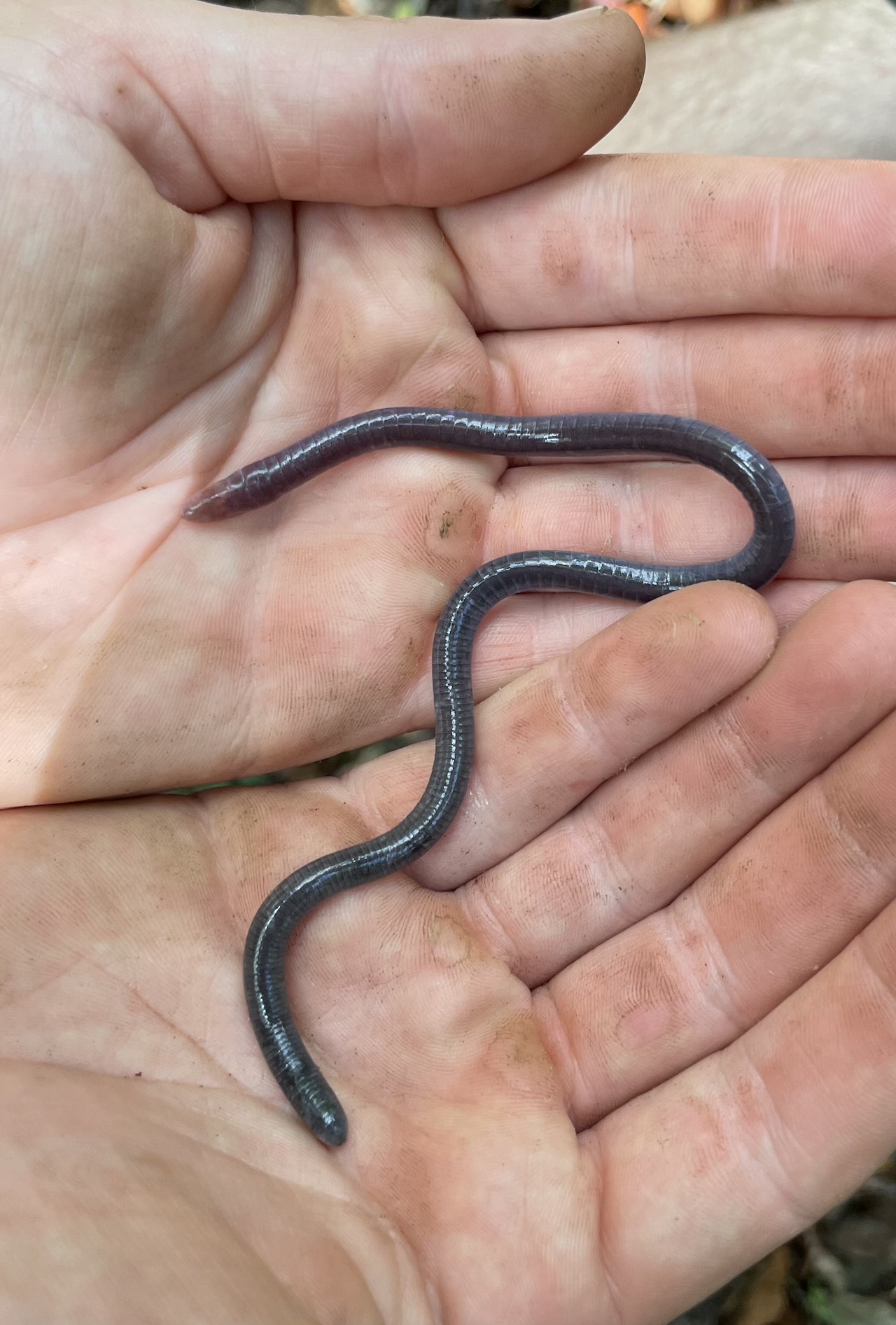
In the afternoon while we waited out the heat, we went for a hike which at its end overlooked the reservoir. Camp was momentarily overrun with howler monkies which we could not get on camera.

Rather than walk the roads for the second night in a row, we elected to cruise the first half and then walk some select sections. Snakes appeared to be less active than the night before as we spotted an Emerald Tree Boa and Two-Lined Forest Pitviper however both were too far away to get a good look at. As we were hiking we came across another labarria and a Surinamese wood turtle. Few photos came from the night and many of us went to bed that night with nothing but wasp stings.
Pepperpot - Day 5
On our final day in Brownsberg, after packing up camp we flipped some rocks which to our surprise yielded our second boa constrictor, first in hand, in the National Park.
Our third destination took us through the capitol of Paramaribo to Pepperpot.
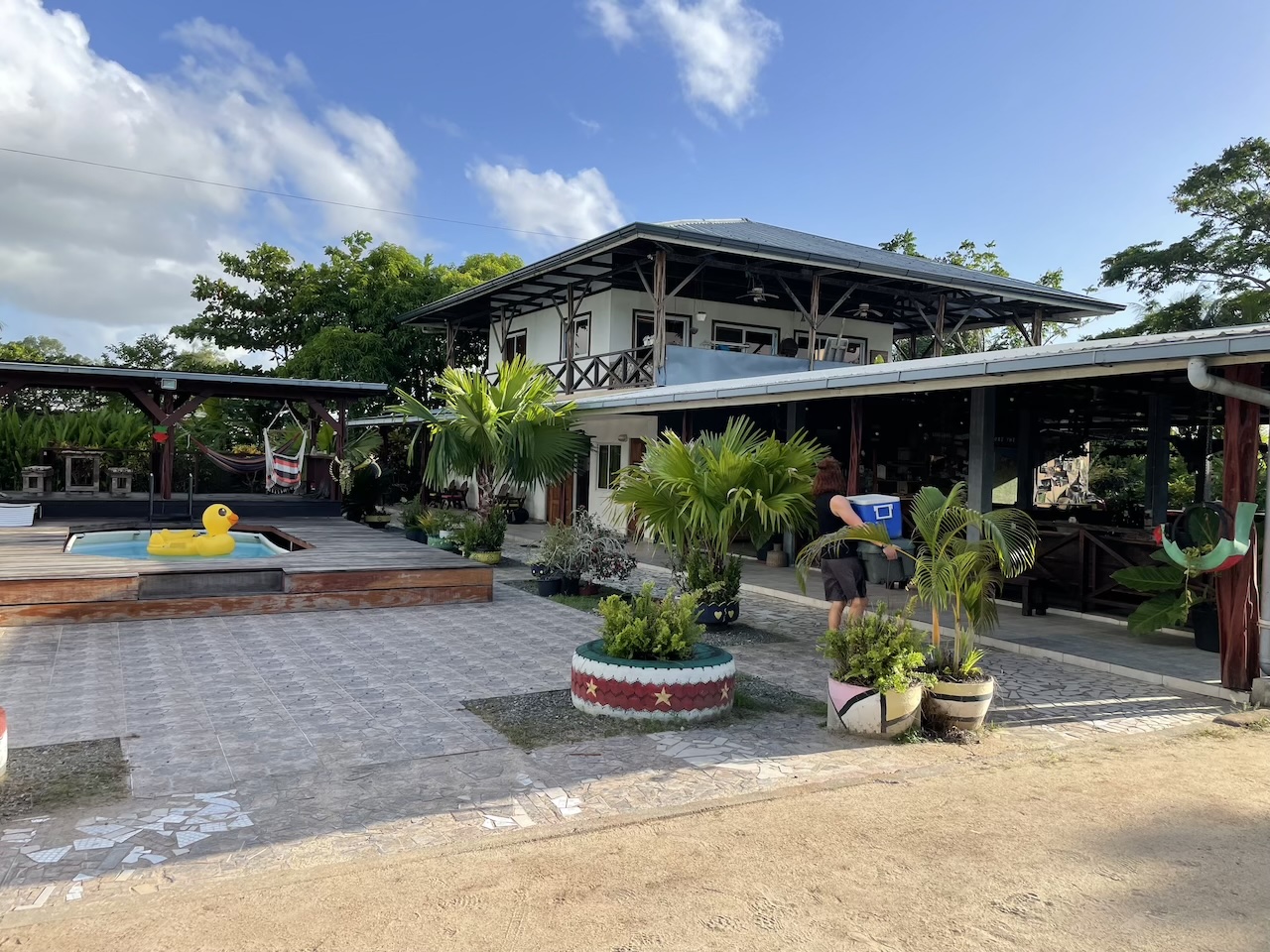
Here we kayaked through some canals shining trees as we went. We came across some Helicops, a parrot snake, and a sipo. The snakes were high up in the trees and hard to get to. Further down the canal we came across some caimen which evaded us quite well and some monkeys.
Marrataka River - Day 6
Early the next morning we drove to the west side of Suriname to the most anticipated location of the entire trip, the Marrataka River! Known for being less trafficked, there are stories of massive fish, flocks of birds, and giant anaconda. Around noon we hopped in a long boat to get south of town to see what the heat brought out. Every floating grassland next to the river was explored and after a few duds we came across the primary target of the trip, a large Green Anaconda!
These snakes are some of the most well known snakes in the world. Known for being the largest and heaviest snakes on the planet as well as being a constrictor. Due to their large size, their semi-aquatic nature allows them to remain mobile. As one could imagine, a 15ft long snake weighing well over a hundred pounds could quickly become overencumbered by its size on land. There are fossil records pointing towards the likelihood of massive snakes upwards of 40+ft long however the largest documented anaconda is around 17ft long. Stories of snakes well into the 20ft territory tied to stories of the most remote places in the rainforest keep the intrigue and mystery that surrounds this snake. As the “capture” of this snake was more involved than most snakes we come across, it was quickly released and unfortunately no photos were taken.
The rest of the day was then spent on the river. Shortly after the anaconda encounter we came across a pack of Giant River Otters, saw blue and gold macaws, toucans, and many more birds. That night we shined an amazon tree boa in the trees along the river.
Palulu - Day 7
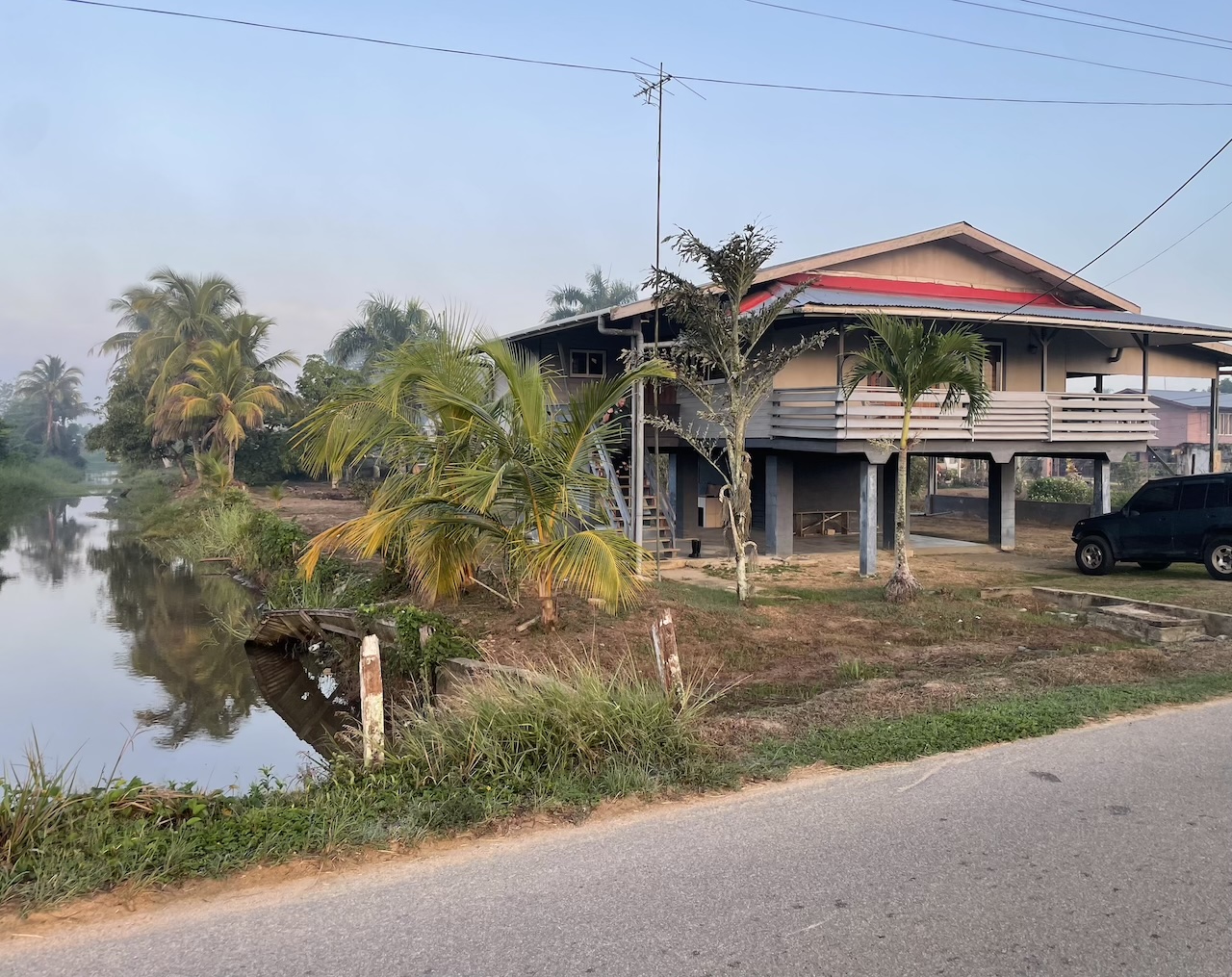
A second morning was spent along the Marrataka River. This time no snakes were found, however the spot of the morning was a crested eagle! Some more fishing took place before heading back to Paramaribo.
After a restful afternoon and evening, the final excursion of the trip is determined to be for the elusive bushmaster. Our guide knows of some hunting property in Palulu and knows he can get permission from the owner. We arrive at the property a around 9/10pm and are shown the entrance to the trails by the owner. This is dense, thick rainforest that looks mostly untouched outside of the occasional hunting/game trail. Lots of getting lost and turning back to find the trail, but we make our way through some rainforest, across a swamp, and to some uphill rainforest. On the way we come across a False Crowned Boa and Ornate Snail Eater before continuing this search well into the wee hours of the morning to no avail. Out of snacks and water, we turn back defeated but not disappointed on the final night.
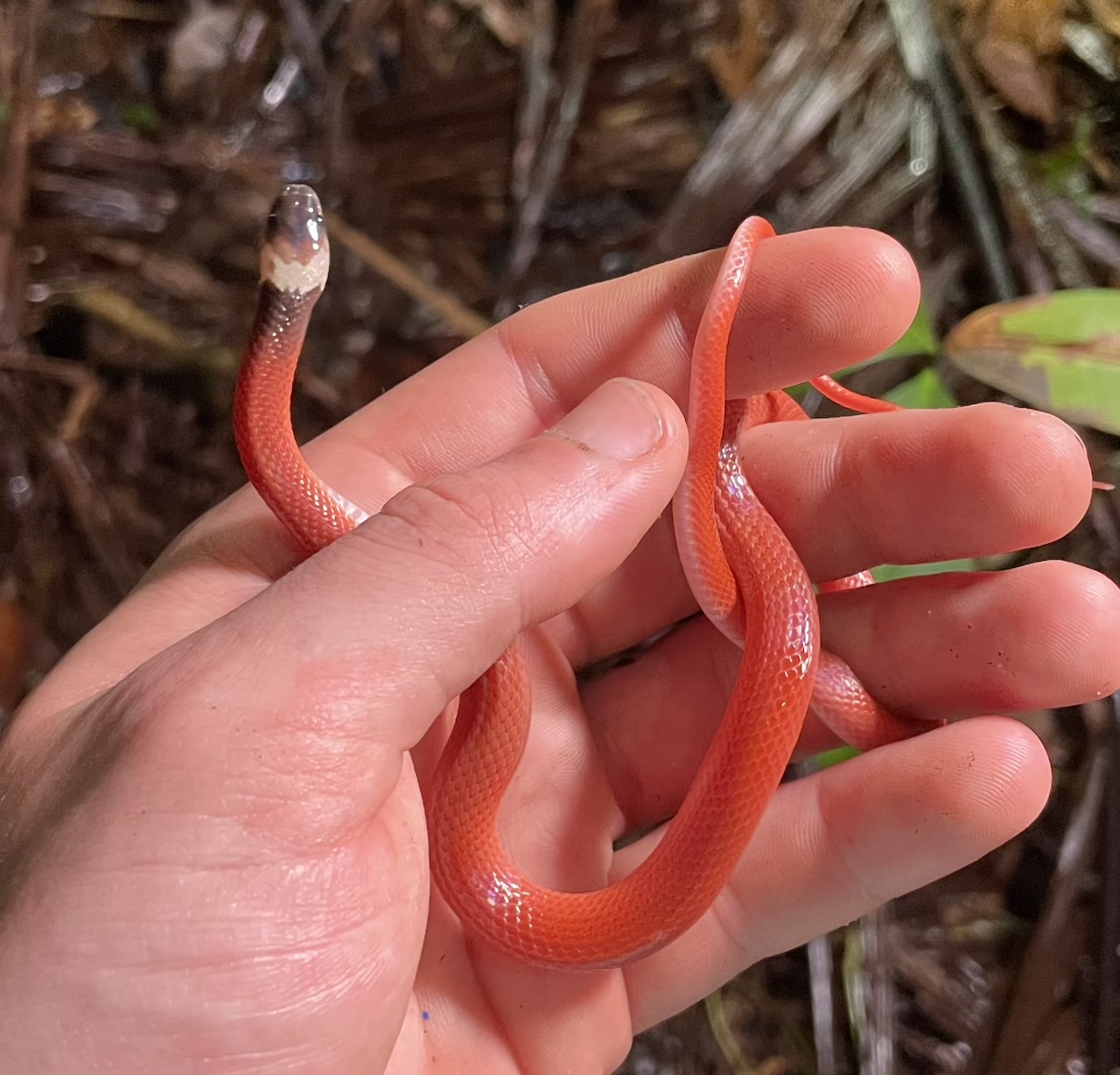

The following day we miss our flights due to traffic and the poor infrastructure throughout the city. The day after, the group part ways as we all rebooked different flight itineraries. I fly from Paramaribo to Trinidad and Tobago to Toronto before landing back in Newark, New Jersey.
Suriname, South America - Trip Totals
Brown Banded Water Snake (Helicops angulatus) 5
Fer-de-lance (Bothrops atrox) 5
Emerald Tree Boa (Corallus caninus) 4
Two-lined Forest Pitviper (Bothrops bilineatus) 3
Boddaert’s Tropical Racer (Mastigodryas boddaerti) 2
Sipo (Chironius carinatus) 2
Amazon Tree Boa (Corallus hortulana) 2
Boa constrictor (Boa constrictor constrictor) 2
Common Blunt-headed Snake (Imantodes cenchoa) 2
Green Sipo (Chironius exoletus)
Brown Sipo (Chironius fuscus)
Wuchers Ground Snake (Xenopholis scalaris)
Guyana Blind Snake (Epictia tenella)
Parrot Snake (Leptophis ahaetulla)
Green Anaconda (Eunectes murinus)
Tschudis False Coral Snake (Oxyrhopus melanogenys)
Crowned False Boa (Psuedoboa coronata)
Ornate Snail-eater (Dipsas catesbyi)
Snakes Seen: 36
Species Seen: 18
Lifers Seen: 17